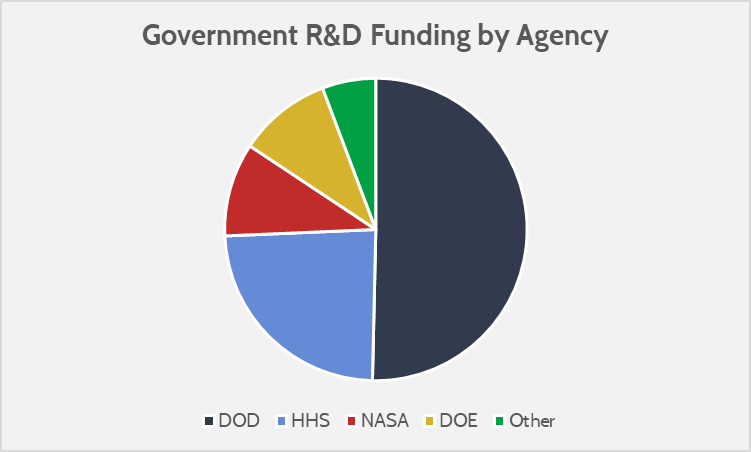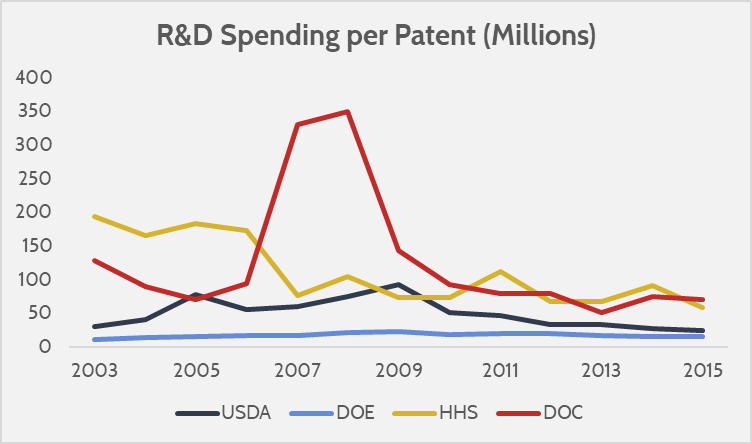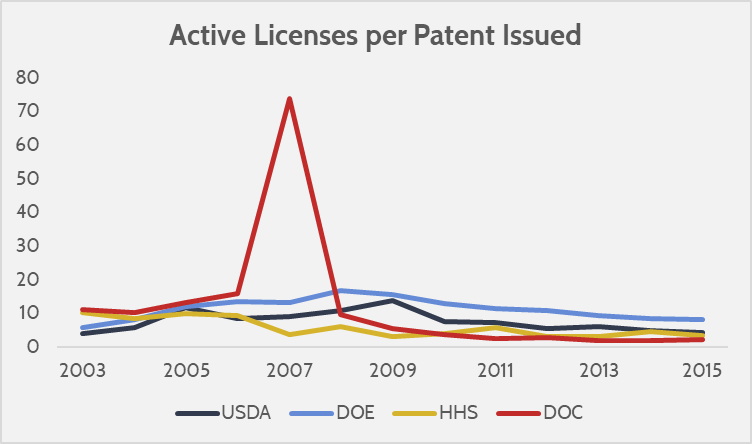Research
November 16, 2018
How to Get the Most Out of the Government’s Research Spending
- The government spends a lot on Research and Development—approximately $124 billion per year—with the aim of bolstering economic productivity.
- This spending is often criticized as being less efficient than if left to the private sector and is frequently a target of budget cuts, especially in the Department of Energy (DOE). Data show, however, that the DOE is by far one of the most efficient producers of government research, producing 3.5 times as many patents per dollar spent and receiving nearly twice as many licenses per patent as the government average. A past analysis from AAF found that DOE patents were more expensive to produce than the private sector, but more highly sought after as well.
- Reforms to government research and development efforts should aim to capitalize on the successes of DOE, which are principally rooted in its high deference to researchers, a focus on private-public partnerships, and technology commercialization.
Introduction
“Productivity isn’t everything, but in the long run it almost is.” Paul Krugman noted thus regarding economic growth, and it is no surprise that the United States government invests heavily in efforts to improve productivity. The federal government spends approximately $124 billion on innovation investments every year, with an aim of advancing new technologies that can increase productivity in the economy.
While economists generally agree about the importance of the government’s investments in this area, this federal spending is often under fire, as its value can be hard to determine tangibly. This critique raises several related questions. Is the U.S. government spending taxpayer funds efficiently in its innovation efforts? Are these funds producing inventions that prove valuable to the market? Are the funds displacing private-sector capital (i.e. moving risk from the private sector to taxpayers)?
The answers to these questions will indicate how successful the government’s spending has been in the past, as well as highlight opportunities for reform.
The Current State of Government-Funded Innovation in the United States
The government spends approximately $124 billion on innovation programs each year, with most of the money being spent on Department of Defense (DOD) research. Other major programs are at the National Institutes of Health (NIH), the National Aeronautics and Space Administration (NASA), and the Department of Energy. Although these agencies represent the lion’s share of government innovation funding, there are many agencies that have at least some small research and development (R&D) efforts. Below is a table showing, for 2015, these agencies’ funding, the number of patents they produced that year, and the number of active licenses for patents they have produced.
| Agency (2015) | Patents Issued | Active Licenses | R&D Funding (millions) | R&D Funding per Patent (millions) | Active Licenses Relative to New Patents |
| USDA | 94 | 424 | $ 2,339 | $ 24.9 | 4.5 |
| DOC | 20 | 44 | $ 1,417 | $ 70.9 | 2.2 |
| DOD | 623 | 560 | $ 62,251 | $ 99.9 | 0.9 |
| DOE | 755 | 6310 | $ 12,295 | $ 16.3 | 8.4 |
| HHS | 501 | 1767 | $ 29,624 | $ 59.1 | 3.5 |
| DHS | 4 | 4 | $ 704 | $ 176.0 | 1.0 |
| DOI | 3 | 20 | $ 784 | $ 261.3 | 6.7 |
| DOT | 1 | 2 | $ 719 | $ 718.8 | 2.0 |
| VA | 51 | 200 | $ 612 | $ 12.0 | 3.9 |
| EPA | 7 | 37 | $ 521 | $ 74.4 | 5.3 |
| NASA | 123 | 375 | $ 12,360 | $ 100.5 | 3.0 |
| Total | 2182 | 9743 | $ 123,626 | ||
| Total (without NASA or DOD) | 1436 | 8808 | $ 49,015 | ||
| Average | $ 56.7 | 4.5 | |||
| Average (without NASA or DOD) | $ 34.1 | 6.1 |
Source: National Institute of Standards and Technology Federal Laboratory Technology Transfer Summary Reports, and National Science Foundation Survey of Federal Funds for Research and Development
The above data show that the DOD is the largest consumer of R&D spending and produces a huge number of patents and patent licenses each year. NASA similarly consumes a large portion of the government’s R&D spending. Economic growth is not the stated objective of these organizations, however. While they often provide spill-over benefits, and many inventions seeded in those agencies make it to market, they do not offer the best comparison to an agency like the DOE, which explicitly has an innovation mandate, in addition to its other missions (nuclear weapons, nuclear nonproliferation, etc.). Without NASA and DOD, the government’s innovation spending shrinks to less than half, at $49 billion.
The above table showing investments and innovation outputs does not tell the whole story, however. More important than merely the number of patents and inventions produced by these agencies is the rate at which they produce patents relative to the funding they receive—effectively their invention productivity. It is also important to note the rate at which those patents are licensed. An invention by itself is of little value until it has reached the private sector. While inventions held by the government can certainly offer some value to the public (especially in terms of security-related inventions), most inventions must be deployed commercially to realize their full potential value (computers, GPS, air travel, the internet, etc.). A patent license indicates an investment by another party to commercialize an invention, showing that the invention holds value and will improve economic productivity. These data comparisons indicate significant variation across agencies. Note that DOD and NASA are excluded from the charts, as their R&D objectives are not intended to yield an economic benefit.
Source: National Institute of Standards and Technology Federal Laboratory Technology Transfer Summary Reports
Source: National Institute of Standards and Technology Federal Laboratory Technology Transfer Summary Reports
The DOE consistently outperforms other agencies along these metrics. When including the DOD and NASA, the DOE produced 3.5 times as many patents per dollar spent on its research than the government average in 2015, and engaged in nearly twice as many licenses per patent. Excluding the DOD and NASA, the DOE still produced 1.9 times as many patents as the government average and got 36 percent more licenses per patent. While budget-conscious politicians often want to cut energy programs, as they represent some of the largest government spending initiatives, they are currently among the most efficient. A holistic view of government innovation spending should acknowledge that while the DOE risks displacing private sector capital, its high productivity of innovation relative to other agencies makes it more likely to be a worthwhile investment relative to other government-funded innovation efforts.
Furthermore, the degree to which DOE’s R&D funding displaces private sector capital may not be as significant as suspected. If public funding were totally displacing private sector capital, we would expect companies to rarely risk their own capital to conduct energy research, but data from the National Science Foundation’s Business Research Development and Innovation Survey indicate the opposite. The data show that businesses that engage in energy research are more likely to be using their own funding rather than outside funding, but we would expect that if government R&D funding were crowding out private sector investment, these companies would be less willing to risk their own capital.[1] The opposite dynamic can be observed, for example, in the defense industry, where it is assumed that the incentive is to allow others (or the public) to undertake defense costs, and the public already undertakes large R&D burdens.[2]
These data do not show another important point about the DOE’s research: It is in high-value industries. Four of the DOE’s top 10 patent categories are in industries that command high average patent licensing costs, indicating that their inventions are in high demand by the private sector.[3]
The data demonstrate that there is a huge degree of variance in the productivity of the government’s innovation efforts, and some programs are certainly worthier of scrutiny than others. Despite the DOE often being a ripe target for government cuts due to the high visibility of its programs—the latest budget request from the Trump Administration proposed cutting $1.9 billion from the DOE’s research budget, a 17 percent reduction—the DOE’s research is not low-hanging fruit for budget trimming. In fact, if the goal is spending reform for the government’s innovation programs, cutting the DOE’s research funding represents the least efficient starting point.
Organizational Structures Drive Outcomes
The DOE is consistently more efficient with its R&D spending than other agencies, and this efficiency can be attributed in part to its unique organizational structure. The DOE has a specific model, called the “Management and Operating Model” (M&O), which allows the National Labs operating under the DOE to have a high degree of autonomy. This structure was borne out of its nuclear weapons development efforts in the first half of the 20th century, and it emphasizes objectives, and not political mandates.
One useful contrast is the American Recovery and Reinvestment Act (ARRA). The ARRA was intended as a stimulus for the economy, and as such directed a lot of federal funds to initiatives that were viewed as “creating jobs” rather than focused on long-term efficiency. Appropriations for these efforts sometimes came at the expense of other efforts. R&D appropriations in 2009 shrunk when excluding ARRA, but increased when including ARRA, which made up 4.9 percent of total R&D funding.[4] The effect of the change in appropriations meant that lawmakers effectively were requesting certain kinds of research, instead of leaving these decisions to the discretion of researchers. This interference in the direction of government research likely caused the efficiency of the research to decline: Government agencies produced more patents, but had fewer licenses per patent than before. These data are consistent with the idea that while they may reflect the desires of their constituencies, legislative bodies are less effective at identifying value than are individuals participating in the industry, whether government researchers or private organizations.
Moving other government agencies toward the DOE’s model would almost certainly benefit innovation outcomes, as it would reduce discrimination in the method of objective fulfillment. NASA has already taken some small measures to employ innovation models that leverage competition, by way of its Commercial Orbital Transportation Services program, which allowed NASA to set product requirements and allow the private sector to compete for product fulfillment. Looking more broadly, if research funding is distributed in a less politically directed manner, and if politicians limit themselves to identifying broad objectives rather than specifying how to achieve those objectives, then R&D spending should become more valuable.
The DOE offers another valuable example in its emphasis on commercialization. It has implemented several programs to this end, including education for researchers on how to make their inventions marketable to businesses (the Labs-Corps program) and online web portals that allow potential purchasers to “shop” for useful patents. The DOE also dedicates a portion of its innovation funds to help inventions move into the prototype stage.
Policy Proposal
At a fundamental level, the challenges facing government-funded innovation hinge on a simple fact: Industry participants are best positioned to know what innovations are valuable. Reforms to innovation funding therefore can take a couple of different approaches. Reforms can seek to remove political influence on the details of government research, they can encourage more private sector partnerships, or (ideally) both. Current innovation policies are unduly restrictive, and politically controlled policies bar the private sector from attaining their full potential of collaboration with existing government research efforts, generating a significant number of lost opportunities.
The DOE is pursuing better private-public collaborations. Secretary Perry last year remarked on his hope to establish a competitive system for contracting using prizes as incentives. He also established a pilot program, subsequently made permanent—the Federal Agreements for Commercializing Technology, or FedACT—that allows private companies to partner with the National Labs without covering all of the development costs as the existing Agreement for Commercializing Technology (ACT) does. Similarly, the Department of Commerce’s National Institute for Standards and Technology is looking into ways to improve public-private partnerships, such as by allowing partners to retain copyrights and trade secrets.
President Trump has signed into law two major innovation bills: H.R. 589, the Department of Energy Research and Innovation Act, and S. 97, the Nuclear Energy Innovation and Capabilities Act of 2017. H.R. 589 seeks to promote the accessibility of publicly-funded research and facilities to the private sector by, for example, increasing funding for invention demonstrations to facilitate commercialization, establishing a public database of all unclassified cooperative R&D agreements, codifying the ACT program as law, and exempting universities and non-profits from having to bear the costs of collaborative R&D with the National Labs. S. 97 similarly eases restrictions on collaboration between publicly funded labs and the private sector, and it focuses on improving the deployment of innovations in nuclear energy by allowing the private sector to fund advanced nuclear reactors to be built by the National Labs.
Recent efforts both in the Trump Administration and in Congress are welcome developments that show a good recognition of the current barriers to technology transfer effectiveness, but more could be done. The DOE would also be wise to update its Technology Transfer Execution Plan, which could serve as an outlet to evaluate programs such as the Technology Commercialization Fund, the success of technology-transfer programs (such as Labs-Corps, FedACT, and Technology-to-Market requirements under ARPA-E), and offer insight for implementing Secretary Perry’s proposed prize-based technology-transfer efforts.
Congress should also be looking to the DOE as a model for success in technology transfers and seek opportunities to apply the M&O model and the DOE’s technology transfer efforts to other federal agencies. NASA, DOD, and NIH are huge recipients of federal funding for innovation, but their lower efficiency compared to the DOE indicates that they would do well to implement several of the DOE’s policies.
Above all, Congress should seek to limit legislative and executive branch influence on the minutia of research of the various agencies. Freeing research directors to pursue what they see as the most promising research, without undue direction with regard to specific strategies, will likely improve the efficiency of federal innovation spending.
Conclusion
The DOE’s research programs offer a model for how the federal government can best support productivity-improving innovation. To be sure, the DOE’s programs are not perfect, but all government research efforts should avoid unnecessary political interference and promote, where possible, partnerships with the private sector. The result could be more valuable inventions for less money—and a stronger economy in the long run.
[1] National Science Foundation, “Business R&D and Innovation Survey 2015,” tables 28 and 36 (August 30, 2018). https://www.nsf.gov/ncses/nsf18313/#&
[2] Ibid, tables 29 and 37.
[3] Of the DOE’s top 10 patent categories reported by the government, 4 of those coincide with the top 10 industries reported by the National Science Foundation to have the highest license revenue relative to the number of patents produced per year—electrical machinery, chemical engineering, semiconductors, and computer technology.
[4] National Science Foundation, “Federal Funds for Research and Development: Fiscal Years 2009-11,” obligations by outlays, by agency. https://www.nsf.gov/statistics/nsf12318/pdf/tab4.pdf













